See also Guangzhou-Nanhai Temple, the starting point of the Maritime Silk Road
Walking time: 2020.7
D1:
Walking method: Self-driving by plane (Nanjing-Guangzhou)
Walking route: Nanhai Temple (Tour time: 1.5 hours, ticket: 15 yuan) Lingnan Impression (Arrived at 16:40, closed at 5 o'clock, unable to enter) Guangzhou University Town Science and Technology Museum (appearance) Foraging on Beijing Road
Check-in: CityNote Sinoo Hotel (Guangzhou Beijing Road Dafosi Park Front Subway Station Branch)271 yuan/standard room
D2:
Walking method: walking, renting
Walking routes: Lu Xun Memorial Hall (1.5 hours, online reservation in advance, tickets are not available), Guangdong Museum (1.5 hours, online reservation in advance, tickets are not available), United Bookstore
Check-in: Beijing Road Sino Hotel
D3:
Walking methods: walking, subway
Walking routes: Nanyue Palace Museum (1.5 hours, no tickets), Yuexiu Park (2 hours, online reservation in advance, no tickets), Guangzhou Museum, Yuehai Tower Foraging
Check-in: Jinzhou International Hotel
D4:
Walking method: walking, renting
Walking routes: Sun Yat-sen Memorial Hall (free tickets for medical staff), Beijing Road, Tao Tao Ju foraging
Check-in: Huamao Hotel
D5:
Walking methods: bus, taxi, subway, plane (Guangzhou-Nanjing)
Walking route: Shangxia Ninth Street, Xiguan Dawu, Liwan Lake Park, Xintai Le Dining
It has become a pattern that I always have to make one trip with my children during holidays. Even a foodie, he still chose Guangzhou, a place of delicious food. Then go. Wherever you have been, you will visit it again and again because of the delicious food, the beautiful scenery, or because a person will visit it. Guangzhou accounts for all three to me.
1,500 kilometers, choose to travel by plane. Take good protection during the epidemic and wear masks throughout public places. During the epidemic, I felt that the phenomenon of plane delays was much less. I wonder if there are statistics to confirm my feeling. Arrived at Guangzhou Airport on time, and a friend drove to pick us up. The city under the blue sky and white clouds.

Every time I visit a city, I feel in a bright mood. I leave a familiar place and come to a city that doesn't belong to me, with a little curiosity, a little expectation, and a little excitement. Guangzhou is familiar to me, but I also have this feeling.

The weather is fine, and the white clouds seem to be floating in the sky. You can stretch out your hand as if you can pull them down. My friend is a cheerful and optimistic person, and his smiling face is as enthusiastic as the bright weather in Guangzhou. Strange cities are no longer unfamiliar because I have friends.

Driving away from the airport, the navigation destination is a friend's workplace. Subtropical scenery along the way.


After dining near my friend's company, my friend handed me his car. After a simple study, I took this tram and set off for our destination-Nanhai Temple. This trip was all done by children. He said he would visit the starting point of the Maritime Silk Road. After coming to Guangzhou many times, I didn't know of such a place. Let's start and fill in your own gap! It was the first time I drove a tram, and I started to be a little cautious. Only after leaving the complex Urban area did I feel relaxed.

Nanhai temple
Address: No. 22 Xuri Street, Miaotou Village, Huangpu District, Guangzhou City
Follow the navigation to the parking lot on the west road of the power plant, park the car, go to the ticket office to scan the code to verify the health code, and then take the ticket to the scenic spot after a series of procedures for purchasing tickets.

A green river surrounds the scenic area, and the canna blossoms by the river are blooming brightly.

A bridge spans the river

The other end of the bluestone arch bridge is the Ximen Archway
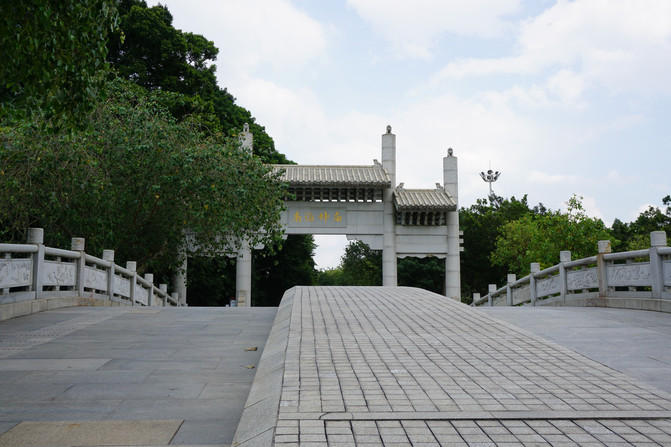
Looking up at the archway under the blue sky

Subtropical flowers and plants are always so enthusiastic

Panorama of the scenic spot guide and introduction to the scenic spot

The southernmost part of the scenic area is the Ming Dynasty dock ruins. The site is located to the south of the foot of Zhangqiu. A road was built from the weathered rocks on the bank of the foot of the mountain to the Pearl River. It has a total length of about 125 meters. It consists of a dock, a connecting pavilion, a small bridge and an official road paved with red sandstone stone. The Ming Pier site has now been backfilled for protection. What you can see now is a ground simulation display using red sandstone substrate on the original site in 2018.

A large sloping square, lined with walls of the "Polo Complete Picture". The complete map of Boluo comes from the book "Polo Waiji" in the Qing Dynasty. The picture depicts the famous scenery on both sides of the Pearl River, starting from Humen in the east to Yuzhu in the west during the Qianlong and Jiaqing periods.
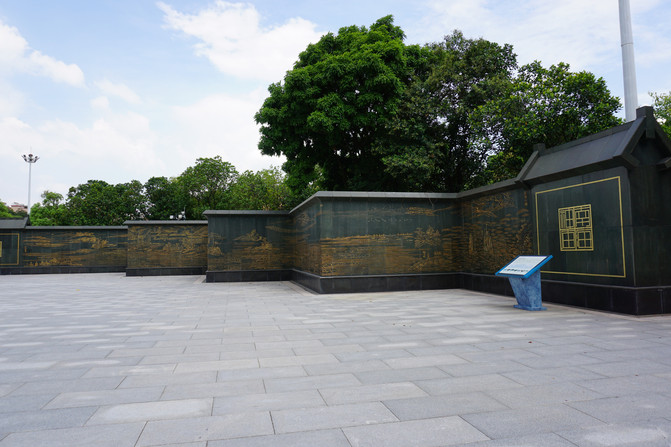
Surrounded by green trees outside the square, several small boats rest quietly here. Sunlight shines through the mottled light and shadow of the leaves, giving this place some dreams.

The tall Polo tree was already fruitful. It is known from Baidu that Nanhai Temple, also known as Boluo Temple, was a place where ancient Chinese working people sacrificed their sacrifices to the sea. It is the only surviving architectural relic among the four major sea gods temples in ancient southeast and northwest China. It is a place where ancient emperors sacrificed their sacrifices to the sea god. It is also an important historical site of foreign trade in ancient China.

There are many stories about the Polo tree. Legend has it that during the Tang Dynasty, a tribute envoy from the Baltic State of ancient India came to Beijing to pay tribute. He came to the Nanhai Temple and placed two Baltic tree seedlings he had brought with him in front of the temple. The polo tree grows bigger and bigger, and the longer it grows, the more outstanding it becomes, so the Nanhai Temple is commonly known as the polo Temple. The Baltic trees we see now were planted by city leaders on the opening day of the renovation of the Nanhai Temple in 1986.
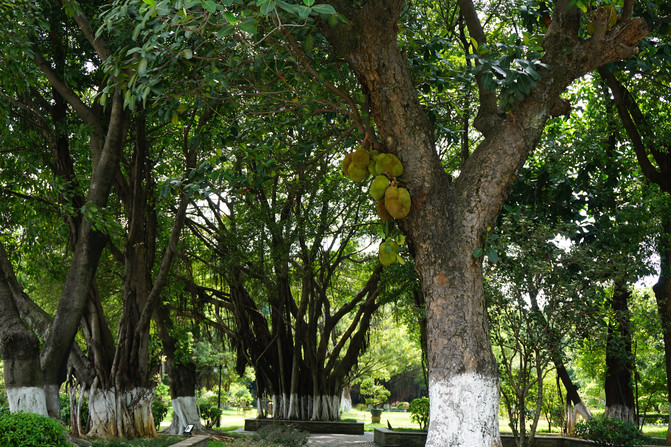
There is a lake in front of the square-the artificial lake in front of the temple. Across the lake is a modern power plant.

Looking around the lake, you can see that the subtropical vegetation is so green and lush, and everything is wrapped in this varying shades of green.

I don't know if the cable bridge I saw across the tall arbor forest is the Huangpu Bridge, but judging from its location, it should be.
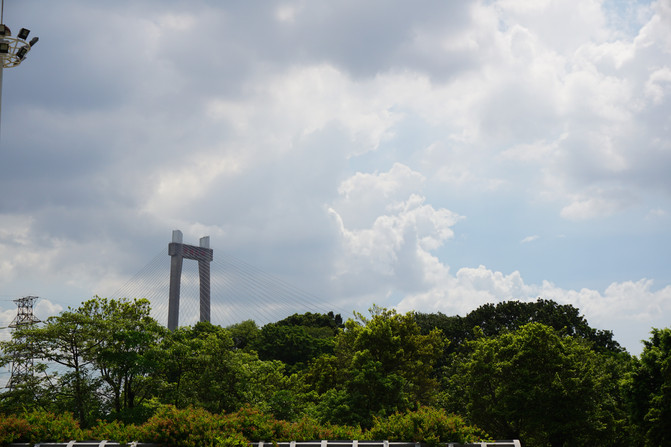
On the north side of the lake is the Nanhai Temple surrounded by green trees.

The pink bougainvillea pinched her mouth and smiled brightly.

This is a dock site in the Qing Dynasty. The site was unearthed through archaeological excavations during the renovation of Temple South Square in 2005. It is divided into two parts: the quay and the road. The quay is located at the southernmost tip of the dock. The dock is paved with gravel. There are nine hydrophilic steps in total, and the steps are completely preserved.

The five-stone road leads north to the archway and leads to the temple. Standing here, you can see the Fuxu Gubu archway by the artificial lake. Nanhai Temple is located in Fuxu Town at the mouth of the Pearl River. It is on the north bank of the Pearl River and faces the Fuxu River. It is connected to Shizi Ocean in the east, Humen at the bottom, and Guangzhou is backed by its back. It is an important sea transportation center for entering and leaving Guangzhou in ancient times. Through this, you can reach the South China Sea Countries.

I didn't expect this to be a dock. It looks like a pond, not connected to the river, let alone connected to the sea. In my imagination, the starting point of the Maritime Silk Road must be at the seaside. Even if the temple gate does not face the South China Sea, it should face the Pearl River! Now it is just a pond, an artificial lake, a large area of elevated cables, and towering chimneys. But none of this can obscure its history. According to records, at the Siyi Port site of Guangzhou Port, Nanhai Temple is the earliest port site and a landmark building of the Maritime Silk Road. The ancient dock we see in the Qing Dynasty was discovered when the Gothenburg returned to Huangpu and the square in front of the construction of the Nanhai Temple. The discovery of the ancient dock proved that the Pearl River water in the Qing Dynasty still reached the "Haibu Yangbo" archway, and most people who went to the Nanhai Temple left the ship and landed here.

There is a huge banyan tree in the middle of the square.

In the scattered vegetation, the octagonal pavilion with yellow glazed tiles and double roofs-the Kaibao Stele Pavilion in the Northern Song Dynasty looks particularly beautiful.

Standing in the middle of the square, this rough and exquisite "Sea Buyangbo" stone archway is like the LOGO of the Nanhai Temple. Before the Ming Dynasty, it was a wood-structured archway, but after the Ming Dynasty, it was changed to a stone archway. The current stone archway is a Qing Dynasty building. It has three rooms and four pillars, rough and simple stone materials, and is a typical legacy of the Qing Dynasty. The sea does not raise waves means that the sea is calm and the waves are as flat as a mirror. It also symbolizes smooth sailing and returning home with a full load. Haibuyangbo is the most sincere hope for peace for all those who walk out of this prosperous ancient port!

Passing the archway is the courtyard of the head gate.

There are a pair of stone lions and a pair of green stone tables in front of the courtyard to the east and west, which shows the majesty and extraordinary bearing of the ancient temple.

The head gate of the Nanhai Temple was built in the Qing Dynasty. It has a brick-and-wood structure, three rooms wide, a hard mountain top, and two dragons fighting for beads and pottery and plastic ridge. There are a pair of red sandstone stone lions in front of the door, and eight-character walls are on both sides. There are front and rear school platforms at the front door. Above the door is a gilded horizontal plaque of "Nanhai Temple".

On the east and west sides of Qianshu Terrace, there are two statues of Shunfenger and Clairvoyance.

They have guarded the temple for thousands of years.

Stand on the steps of the second entrance gate and look back at the front gate and the archway.

The second entrance door. The door of the instrument is three rooms wide and four rooms deep. On the hard mountain top and on the roof beams of the instrument door, there are two black dragons bent in the shape of soaring and galloping. It is competing for the pearl. Both sides are connected to the compound corridor. The ceremonial door is the "door of etiquette". There are three doors. The middle door is only for senior officials and nobles to enter and exit, and other low-ranking officials or ordinary people can only use the side door.

An exhibition of "Old Shadows and New Faces" is being held in the east corridor of the Yimen. It uses pictures and words to introduce the vicissitudes of the Nanhai Temple and a brief introduction to the cultural relics unearthed from the Nanhai Temple.


There is also a pair of stone drums at the entrance of the instrument door.

The "Chinese Ancient Ship Model Ship Exhibition" is on display in the west corridor of Yimen.

There are many types of models, including the three famous ships in ancient China, the main ships of the ancient Maritime Silk Road, and some ships walking on the river.



There is a plaque of "Holy Virtue" hung on the lintel, which means that the kindness of the emperor can be reached by the general public.

From the courtyard of the Yimen to the east and west sides of the fourth entrance hall, there is a compound corridor. A total of 45 steles from the Tang, Song, Yuan, Ming and Qing dynasties are displayed in the corridor. In addition to the Han Yu Monument at the head gate and the Song Kaibao Monument, the famous steles in the temple include the Hongwu Monument of the Ming Dynasty and the Kangxi Monument of the Qing Dynasty... The Nanhai Temple has left many imperial steles to sacrifice to emperors, and many poem steles and Fu steles left by cultural celebrities. Therefore, the Nanhai Temple is also known as the "Southern Forest of Steles."

After exiting the ceremonial gate, behind a large courtyard is the third ceremonial pavilion. This is the place where ancient officials worshipped the Nanhai gods.

The ceremony pavilion, also known as the worship pavilion, was originally built in the Ming Dynasty. The existing ceremony pavilion was rebuilt in the style of the Ming Dynasty. This is a wooden structure building with a single eaves resting on the top of the mountain. It has three rooms in width and three rooms in depth, and is transparent on all sides.

Kangxi Imperial Stele Pavilion on the west side of the garden.

The four golden characters "Thousands of Miles of Waves" on the stele are bold and unrestrained.

An ancient kapok tree planted in front of each of the two imperial steles.


There are still some places in the temple under repair

There is also a famous Eastern Han bronze drum on the east side of the hall. It was forged during the Eastern Han Dynasty, and there are 6 copper frogs inlaid on the edge of the drum.

Next to the ceremony pavilion is the fourth entrance of the Nanhai Temple, which is also the highest-specification and most important building in the entire building complex-the main hall. The main hall is five rooms wide and three rooms deep. The appearance is majestic, simple and solemn. The architectural art of a typical ancient Chinese wooden palace. In the center of the hall is placed a 3.8-meter-high Nanhai God Zhurong.

The fifth entrance to the Zhaoling Palace, also called the rear hall, is the bedroom of the Nanhai Goddess. The roof has a glazed tile ridge with turtles hanging upside down and two dragons competing for pearls.




Arriving behind the Zhaoling Palace, in this way, starting from the "Haibo Buyang" archway on the southernmost side, we visited the main buildings of the temple from south to north along the central axis of the temple: the head gate, the ceremonial gate, the ceremony pavilion, the main hall, and the Zhaoling Palace has a total of five entrances, one entrance higher than the other. Other ancillary buildings are centered on the five entrances and symmetrical left and right. The entire building complex is surrounded by green trees, which is a typical traditional Chinese temple complex.

In addition to the main building of the Nanhai Temple, the surrounding gardens are also built to be full of vitality.

There is a large Lingnan Folk Culture Park in the garden on the west side of the temple.

The park displays stone tools from different eras.

The tall Suzaku Terrace built of stones. The god of the Nanhai Sea is Zhu Rong (Red Emperor), who used the red bird and the rosefinch as the temple emblem, so this rosefinch platform was built. Each Vermillion Bird is exquisite and lifelike, and all faces the same direction.

Wuyulin

Here we show the characteristics of Lingnan architecture: gate and wail wall.

The gate is an important part of the gate style of Lingnan buildings. It has a good anti-theft function. The wok ear wall is also called the Horse Head Wall and the Champion Wall. Lingnan residential buildings were often used in the Qing Dynasty. In addition to decorative functions, they also had fire prevention and shelter from wind.
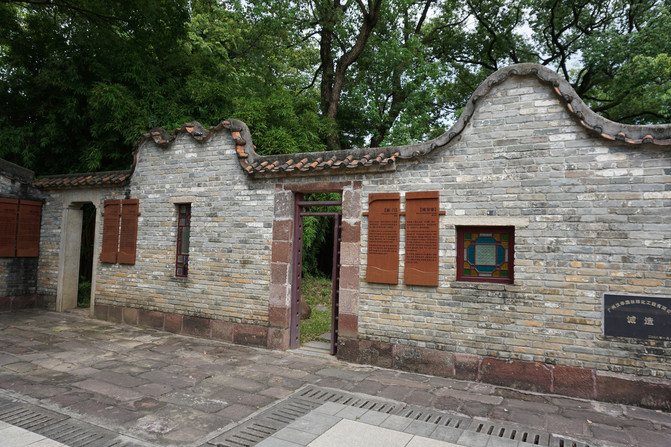
On this side is an oyster shell wall made of shells from oysters. Since the Ming Dynasty, oyster shells have been used in the Pearl River Delta and coastal oyster producing areas
Instead of brick walls, it is durable and distinctive.

Manchurian windows are originally a masterpiece of Manchu architectural art, but they are widely used in Lingnan buildings because of their elegance and beauty.

Brick carving and stone carving, pottery sculpture, gray sculpture, wood carving, etc. are all among the ancient architectural arts of Lingnan.

Wufu Xiangyun Shrimp Bow Beam

stone mill
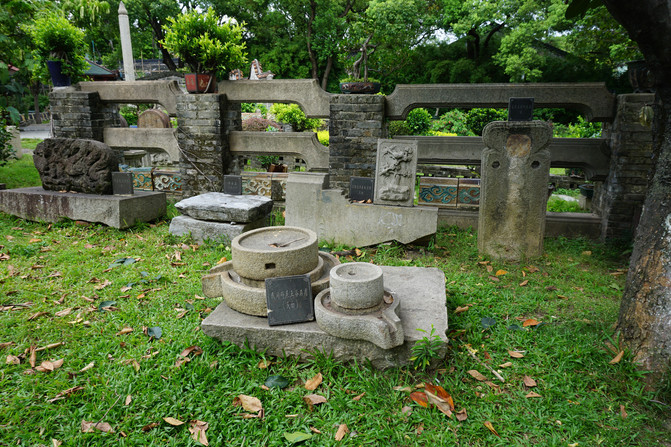
shigu

Shishi
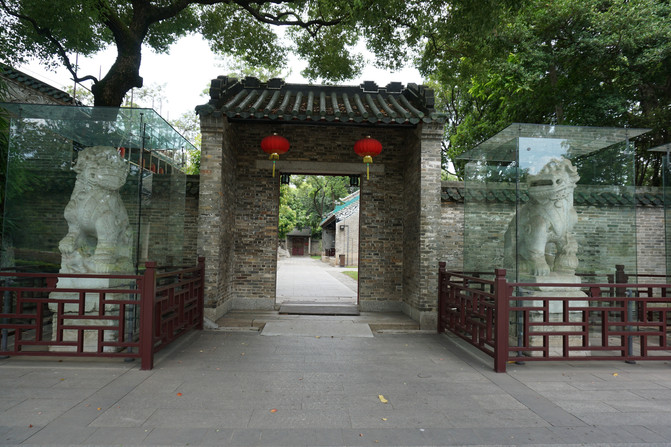
Go to the south end of the Folk Garden

Various ancient trees form forest in the park

On the west side of Nanhai Temple, there is a small hill-Zhangqiu Gang.
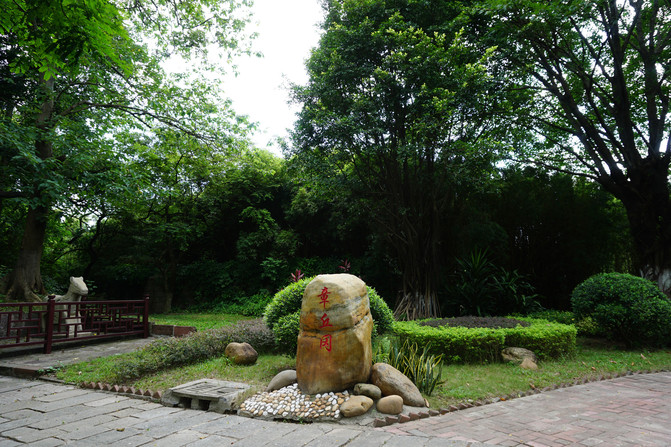
The mountain is only more than ten meters high, with stone steps rising up, ancient trees and sky on both sides, and stone gods at the foot of the mountain and stone beasts guarding it.

There is a sunbathing pavilion on the top of the mountain, and there are relics protected by glass covers beside the pavilion.


The Yusi Pavilion has a single eaves on the top of the mountain, with simple beams and two ancient steles standing in the middle, engraved with the poems written by Su Dongpo of the Song Dynasty and Chen Xianzhang of the Ming Dynasty who visited this place and observed the future.

During the Tang and Song Dynasties, this place was surrounded by water on three sides and people stood in pavilions. It was the best place to enjoy the sea view and express their feelings about the sea. But now the trees here are tall and shady, and you can't see the scenery outside the mountains, let alone watch the sunrise.

Go down the stairs

Driving away from Nanhai Temple, we headed for Lingnan Impression. When we arrived at the ticket office, it was already 16:40, and the scenic spot closed at 5 p.m., so we couldn't enter. Friends knew our location and recommended us to visit the Guangdong Science and Technology Center not far away, saying it was a very special building.
Guangdong Science Center
Address: Panyu District, Guangzhou
The Guangdong Science Center on the banks of the Pearl River is large and magnificent. The shape is very special. Looking down from the Panyu Bridge, it looks like a blooming "kapok".

Entering the parking lot from Kepu Road, the entrance was told that it was past the entry time. I can only look around and see the shape of this giant. From this perspective, it looks like a huge aircraft carrier.

Looking at it from another angle, it looks like an eye with bright eyes.

When all major scenic spots close, we stopped running. Return the car to a friend. I will spend the next few days in the city. Just take the subway. Driving and parking in the city will be very nerve-racking. A friend took us to the subway station, and we took the subway to the BC subway station and walked a few hundred meters all the way to the hotel.
CityNote Chino Hotel (Guangzhou Beijing Road Dafosi Park Front Subway Station Branch)
Address: No. 81 Xihu Road, Guangzhou
The hotel is located in a business building on Longzang Street. Construction is under way on the exterior of the commercial building, and scaffolding is erected on the exterior. We entered the elevator and went to the lobby on the fourth floor to check in. The lobby is not big, but it is decorated in a fashionable and petty manner. All kinds of decorations are very personalized.


There is a warm and romantic restaurant and bar. There will be breakfast here, and snacks will be served. There are not many varieties.


We were given a room close to the community, which was not disturbed at all by the construction of the exterior wall. The room is soundproofed. The room is not large in size, but compact and exquisite. The light source is rich and effective. After a short rest, we each went to Beijing Road to find food.

Previous Article:Guangzhou's summer baby walking holy place is on the Anhua Hui Happy Boat
Next Article:Guangzhou Hot Spring Hotel Recommendation: Spend the weekend parent-child time at Wenxuan Garden in Conghua
